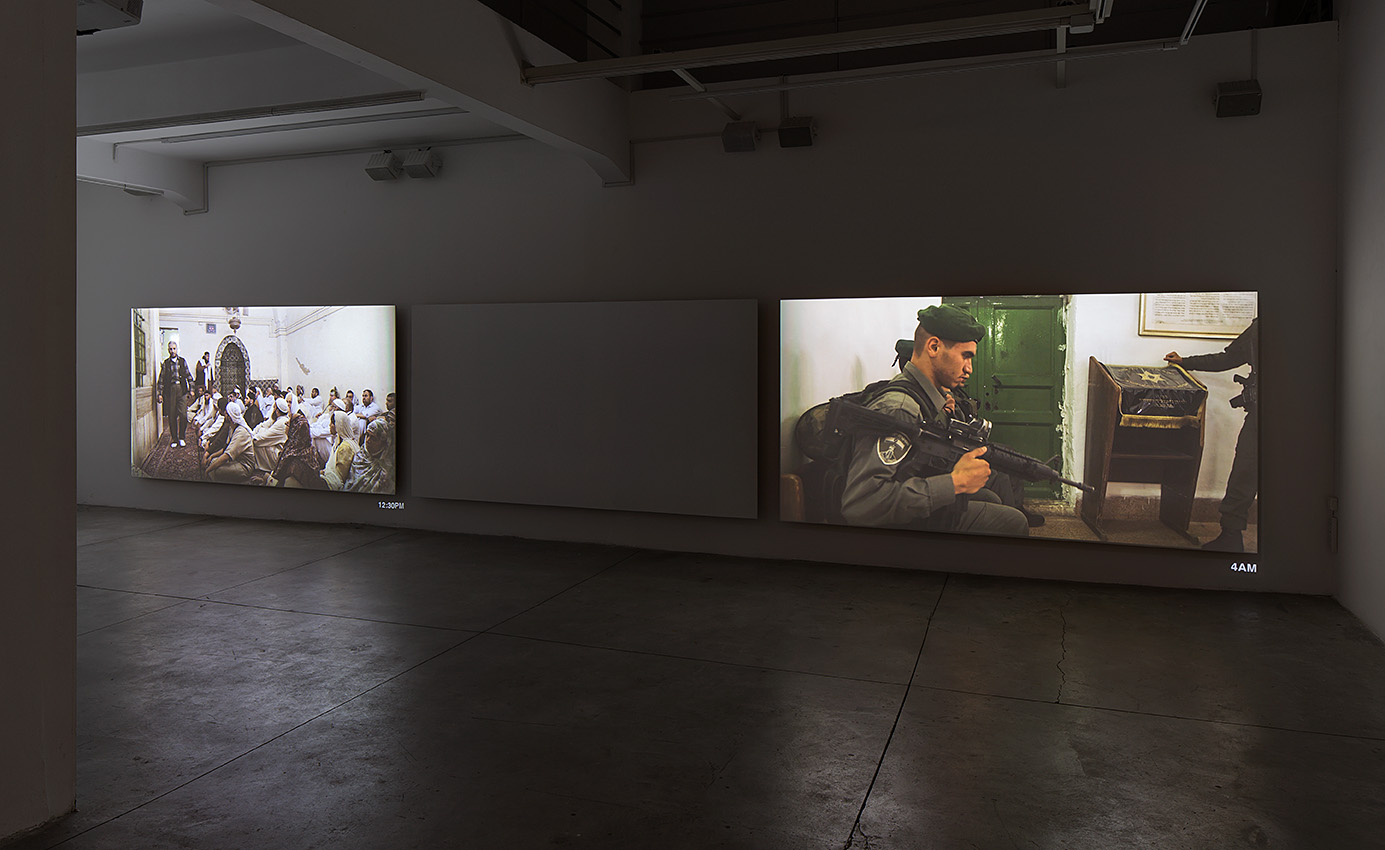
Nira Pereg, ISHMAEL, 2014-2015, (Still from Video). Four Channel HD Video Installation with Sound
10:44 min. Courtesy of Braverman Gallery and the artist.
Nira Pereg’s four-channel video installation Ishmael (2015), was filmed in the Cave of the Patriarchs in Hebron, the West Bank’s largest city. Holy for both Muslims and Jews, the Cave contains the burial sites of the Old Testament figures Abraham and Sarah, Isaac and Rebecca, and Jacob and Leah, and today, is shared through a strict division of prayer spaces: 80 percent mosque and 20 percent synagogue. In Ishmael, a work as visually stunning as the rest of Pereg’s oeuvre, the artist follows those who, five times per day, cross the border between these closed-off spaces. Paradoxically, the adhan (the Muslim call to prayer) is made on the Jewish side, mandating the muezzin who makes the call be escorted by Israeli police through the synagogue, for both his own protection and the Jews.
Pereg filmed in four locations within the Cave, and each resulting video is projected on its own screen: the mosque, the synagogue, the threshold between the two, and the building’s exterior. Denoting the hour at which each scene took place, Pereg’s work begins on the leftmost screen at 4:00 a.m., with the muezzin knocking on a door. After a moment, a metal latch clangs and the heavy door, painted a vibrant green, creaks open as an Israeli border policeman allows the muezzin entry into the synagogue on the second screen; the muezzin proceeds onto the third screen through an empty corridor, escorted by five armed border guards. Later, when the 4:00 p.m. adhan is made, border patrol and Israeli civil police carry out this task together, revealing the multiple security forces asserting authority here. After returning the muezzin to the mosque, these uniformed figures mix together near the threshold, waiting claustrophobically close, for his return for the next adhan. The work ends at 7:30 p.m. on the fourth screen, before now unused, with an older Jewish man strangely emitting his own, uncustomary call to prayer. Israeli security forces did not allow the muezzin to pass through for this adhan, “giving it” instead to the Jews.1
Nira Pereg, ISHMAEL, 2014-2015, (Still from Video). Four Channel HD Video Installation with Sound
10:44 min. Courtesy of Braverman Gallery and the artist.
Nira Pereg, ISHMAEL, 2014-2015, (Still from Video). Four Channel HD Video Installation with Sound
10:44 min. Courtesy of Braverman Gallery and the artist.
In Ishmael, Pereg documents the fragility of the borders within the Cave of the Patriarchs by capturing the extensive bureaucracy that authorizes movement within it and upholds its thin veil of harmony. The gaps Pereg leaves between each screen heighten the performative disparity that affects the populations functioning within the Cave’s thinly drawn borders. Her tightly composed frames constrict the viewer’s perspective, seemingly shrinking the spaces being observed. Both through the work’s looped presentation and the back-and-forth movement captured within the Cave’s elusive membrane, Pereg articulates the Sisyphean quality of this site and of the occupation at large.
How movement is enabled across and between this structure’s borders is important, but the strength of Pereg’s work is in its moments of stillness. Looks of frustration and impatience cross the muezzin’s face as he knocks a second time on the door, waiting for the Israeli police to allow him entry. The glances of nearby worshippers increase this tension, making his inability to proceed a performance. At another point, the Israeli police are captured on the second screen yawning with fatigue and boredom as they wait to be called—for their presence to be of use. Day in and day out, their sole task is to accompany the muezzin through the synagogue, protecting him from whatever harm may be of threat once he crosses over to the Jewish side, where he is outnumbered, and simultaneously ensuring he enters the synagogue unarmed.
Nira Pereg, ISHMAEL, 2014-2015, (Still from Video). Four Channel HD Video Installation with Sound
10:44 min. Courtesy of Braverman Gallery and the artist.
Nira Pereg, ISHMAEL, 2014-2015, (Still from Video). Four Channel HD Video Installation with Sound
10:44 min. Courtesy of Braverman Gallery and the artist.
In this highly contentious space, such measures are necessary, for there continues to exist no shortage of violence in Hebron. Two significant instances are the 1994 Cave of the Patriarchs Massacre committed by settler Baruch Goldstein, which killed twenty-nine Muslims and injured one hundred twenty-five, and the 1929 Hebron Massacre carried out by Arabs that claimed at least sixty-seven Jewish lives, incited in response to territorial tensions at the Temple Mount in Jerusalem. At the Cave of the Patriarchs, protection is ensured by blocking the interaction of religious worshippers and regulated through multiple authorities that provide some sense of safety to their respective populations. But Pereg’s work demonstrates that when religious practice is designed—spatially and otherwise—to depend on security forces, it cannot function apolitically.
Nira Pereg, ISHMAEL, 2014-2015, (Still from Video).
Four Channel HD Video Installation with Sound
10:44 min. Courtesy of Braverman Gallery and the artist.
Ishmael was on view at the Braverman Gallery, Tel Aviv from October 8 – December 10, 2015.
1. From the author’s conversation with the artist, December 6, 2015.